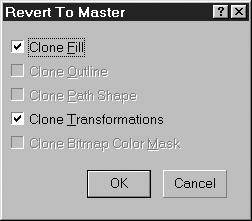There are two ways to copy an object: copy it to the Windows Clipboard (and then paste it into the document) or duplicate it. The result is the same, but the amount of computing power used for the two procedures is different.
If you copy an object to the Clipboard, you can
then paste it into the current page or other pages in your CorelDraw
document. It will also be available for pasting into other Windows
programs. For example, you could paste a rectangle or star copied from
CorelDraw into a Microsoft Word document. However, copying and pasting
an object—especially a complex one—can tie up your computer.
CorelDraw's Duplicate command bypasses the
Clipboard, making it a faster operation. In addition, you can specify
exactly where the duplicate will appear in relation to the original,
whereas a copy will always appear on top of the original.
To copy an object using the Clipboard:
1. |
Select the object you want to copy.
|
2. |
Choose Edit > Copy or press  . .
The object is copied to the Clipboard.
|
3. |
Choose Edit > Paste or press  . .
A copy of the object appears, directly on top of the original.
|
4. |
Drag the copy to the desired position.
|
To copy an object by dragging:
1. |
Using the Pick Tool (or another tool), right-click the object you want to copy and drag it to the desired position.
|
2. |
Release the mouse button.
|
3. |
Choose Copy Here from the pop-up menu that appears (Figure 1).
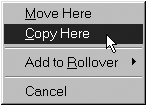
|
To duplicate an object:
1. |
Select the object to be duplicated.
|
2. |
Choose Edit > Duplicate or press  . .
The duplicate appears slightly to the right and above the original (Figure 2).

|
Smart duplication helps you create a series of evenly-spaced duplicate objects.
To create a series of objects using smart duplication:
1. |
Select the object you want to duplicate.
|
2. |
Choose Edit > Duplicate or press  . .
A selected duplicate of the original appears.
|
3. |
Using the Pick Tool, move the duplicate object to the desired position in the series (Figure 3). Be sure to leave the duplicate object selected.
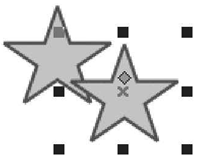
|
4. |
To duplicate the repositioned duplicate object, choose Edit > Duplicate or press  again. again.
A second duplicate appears, positioned the same distance and direction away.
|
5. |
Continue choosing Edit > Duplicate or pressing  until there are as many evenly-spaced duplicates as you need (Figure 4). until there are as many evenly-spaced duplicates as you need (Figure 4).
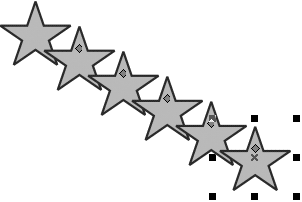
|
Tips
Another quick way to copy a selected object is to press  on your numeric keypad. This places a copy of the object on top of the original.
on your numeric keypad. This places a copy of the object on top of the original.
Remember
that if you're dragging an object with any tool other than the Pick
Tool, you must first select the object and drag from the x in its center.
Cloning objects
Like duplication, cloning bypasses the Clipboard
to quickly create a copy of the original. However, unlike duplication,
cloning creates a link between the
original and the copy. Any changes made to the original also effect the
clone. This is handy, for example, if you have 100 cloned circles in a
drawing and want to change all of their fill colors from red to blue.
All you'd have to do is select the original circle and fill it with
blue.
To clone an object:
1. |
Select an object with the Pick Tool.
|
2. |
Choose Edit > Clone.
A clone appears (Figure 5).
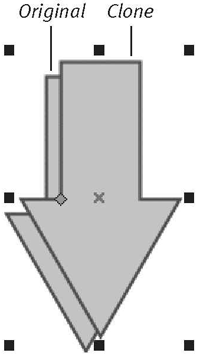
|
3. |
To make additional clones of the same object, repeat Steps 1 and
2. (Note that you must make each clone from the original object; you
cannot clone a clone.)
|
Tips
The link between a clone and the
original goes only one way. If you alter the original, all clones are
changed, too. But if you alter a clone, the original is unaffected.
You
can distinguish a clone from the original by checking the status bar.
If a clone is selected, the description will include the word “Clone.”
If the original is selected, the description will include the word
“Control.”
Once you've altered a specific
attribute of a given clone (its color, for example), that attribute is
no longer linked to the original. However, all other
attributes (shape and size, for example) continue to be linked to the
original. To restore a clone's attributes so that it matches the
original again, right-click the clone and choose Revert to Master from
the pop-up menu that appears. In the Revert to Master dialog box (Figure 6), enter checkmarks for the attributes to be restored and then click OK.
